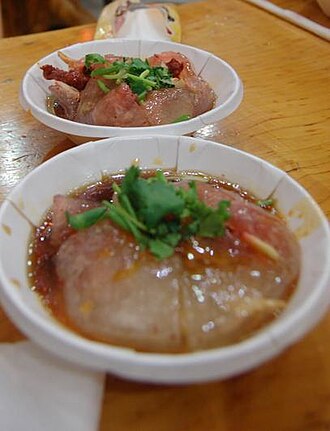Taiwanese cuisine
Taiwanese Cuisine[edit]

Taiwanese cuisine is a rich and diverse culinary tradition that reflects the island's history, geography, and cultural influences. It is known for its bold flavors, diverse ingredients, and the integration of various culinary techniques from different cultures.
History[edit]

Taiwanese cuisine has evolved over centuries, influenced by the indigenous peoples of Taiwan, Chinese settlers, Japanese colonization, and global culinary trends. The indigenous peoples contributed unique ingredients and cooking methods, while the influx of Han Chinese settlers brought traditional Chinese cooking styles. During the Japanese colonial period, Japanese cuisine also left a significant mark on Taiwanese food culture.
Ingredients[edit]
Taiwanese cuisine utilizes a wide variety of ingredients, including rice, pork, chicken, seafood, and an array of vegetables. Common seasonings include soy sauce, rice wine, sesame oil, and fermented black beans. The island's subtropical climate allows for the cultivation of diverse fruits and vegetables, which are staples in many dishes.
Regional Variations[edit]

Taiwan's regional cuisines vary significantly due to its diverse geography. The northern region, including Taipei, is known for its street food and night markets, while the central region, including Taichung, is famous for its pastries and snacks. The southern region, including Tainan, is renowned for its sweet and savory dishes, and the eastern region is known for its indigenous culinary traditions.
Popular Dishes[edit]

- Bawan - A type of dumpling made with a translucent dough and filled with meat and vegetables.
- Chiayi turkey rice - A dish consisting of shredded turkey over rice, often served with pickled vegetables.

- Coffin bread - A thick slice of bread hollowed out and filled with a creamy stew.

Agriculture and Food Production[edit]

Taiwan's agriculture is diverse, with rice being the staple crop. The island also produces a variety of fruits, including bananas, pineapples, and lychees. The fishing industry is also significant, providing a wide range of seafood that is integral to Taiwanese cuisine.
Cultural Significance[edit]
Food plays a central role in Taiwanese culture, with meals often being a time for family gatherings and social interactions. Festivals and celebrations frequently feature special dishes, and the island's night markets are famous for their vibrant food scenes.
Related Pages[edit]
Ad. Transform your life with W8MD's Budget GLP-1 injections from $75


W8MD offers a medical weight loss program to lose weight in Philadelphia. Our physician-supervised medical weight loss provides:
- Weight loss injections in NYC (generic and brand names):
- Zepbound / Mounjaro, Wegovy / Ozempic, Saxenda
- Most insurances accepted or discounted self-pay rates. We will obtain insurance prior authorizations if needed.
- Generic GLP1 weight loss injections from $75 for the starting dose.
- Also offer prescription weight loss medications including Phentermine, Qsymia, Diethylpropion, Contrave etc.
NYC weight loss doctor appointmentsNYC weight loss doctor appointments
Start your NYC weight loss journey today at our NYC medical weight loss and Philadelphia medical weight loss clinics.
- Call 718-946-5500 to lose weight in NYC or for medical weight loss in Philadelphia 215-676-2334.
- Tags:NYC medical weight loss, Philadelphia lose weight Zepbound NYC, Budget GLP1 weight loss injections, Wegovy Philadelphia, Wegovy NYC, Philadelphia medical weight loss, Brookly weight loss and Wegovy NYC
|
WikiMD's Wellness Encyclopedia |
| Let Food Be Thy Medicine Medicine Thy Food - Hippocrates |
Medical Disclaimer: WikiMD is not a substitute for professional medical advice. The information on WikiMD is provided as an information resource only, may be incorrect, outdated or misleading, and is not to be used or relied on for any diagnostic or treatment purposes. Please consult your health care provider before making any healthcare decisions or for guidance about a specific medical condition. WikiMD expressly disclaims responsibility, and shall have no liability, for any damages, loss, injury, or liability whatsoever suffered as a result of your reliance on the information contained in this site. By visiting this site you agree to the foregoing terms and conditions, which may from time to time be changed or supplemented by WikiMD. If you do not agree to the foregoing terms and conditions, you should not enter or use this site. See full disclaimer.
Credits:Most images are courtesy of Wikimedia commons, and templates, categories Wikipedia, licensed under CC BY SA or similar.
Translate this page: - East Asian
中文,
日本,
한국어,
South Asian
हिन्दी,
தமிழ்,
తెలుగు,
Urdu,
ಕನ್ನಡ,
Southeast Asian
Indonesian,
Vietnamese,
Thai,
မြန်မာဘာသာ,
বাংলা
European
español,
Deutsch,
français,
Greek,
português do Brasil,
polski,
română,
русский,
Nederlands,
norsk,
svenska,
suomi,
Italian
Middle Eastern & African
عربى,
Turkish,
Persian,
Hebrew,
Afrikaans,
isiZulu,
Kiswahili,
Other
Bulgarian,
Hungarian,
Czech,
Swedish,
മലയാളം,
मराठी,
ਪੰਜਾਬੀ,
ગુજરાતી,
Portuguese,
Ukrainian